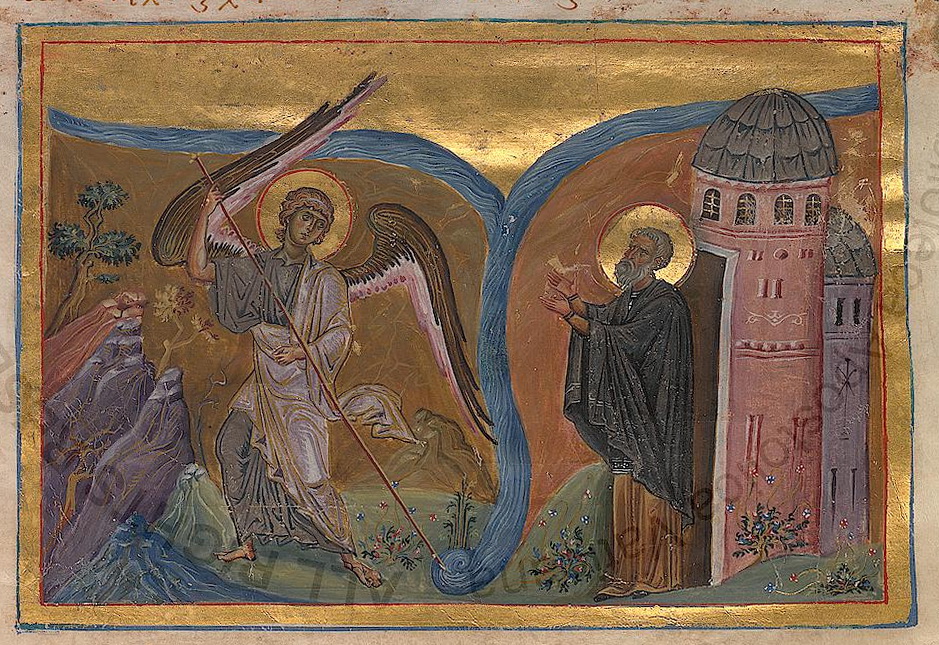Today is the feast of St Michael the Archangel.
Earlier this month John Dillon posted the following piece on the Medieval Religion discussion group about one of the Archangel's apparitions and miracles:
In Byzantine-rite churches September 6th is the feast of St. Michael the Archangel's Miracle at Chonae. According to a legend first documented from the eighth century, the famous Michaelic sanctuary at Chonae (more Hellenicly, Chonai) in the East Roman theme of Thrakesion -- now Honaz in Turkey's Denizli province -- was the scene of a miracle vouchsafed to the holy hermit Archippus after he had lived there for seventy years. The site, located in a valley between two arms of a river, consisted of a healing spring long associated with Michael and an adjacent oratory dedicated to him. Local polytheists plotted to destroy the oratory by redirecting two nearby mountain rivers to a point above the site, damming them, and then releasing the impounded waters; the latter in their flood would wash away the oratory and the newly created joint river would permanently drown the spring.
Made aware of these machinations, the elderly Archippus called upon Michael for assistance. The archangel appeared, telling Archippus not to fear. As the wall of water approached Michael first caused it to stand perfectly still and then, striking a rock, created at that point a great chasm into which the waters funneled and through which they have flowed ever since, thus sparing the spring and its oratory to serve as an always efficacious source of healing. Thus far the story, which exists in at least three Greek-language versions (BHG 1282, 1283, and 1284) as well as in an Ethiopian one (BHO 759) and in one in Latin from the eleventh century (BHL 5947; the work of a monk named Leo at the Amalfitan monastery on Mt. Athos).
The sanctuary at Chonae (a place whose name in Greek means Funnels) was already well known in the later fifth century. It prospered until the later twelfth century and was the venue for a great annual gathering on this day. Among the many who traveled there was St. Lazarus the Galesiote (d. 1053); it was there, according to Gregory the Cellarer, that he met the monk whom he accompanied to Palestine. In Russia, the originally later fourteenth-century Chudov monastery in the Moscow Kremlin was dedicated to the Miracle at Chonae.
Some medieval images of the Miracle at Chonae:
a) The Miracle at Chonae (grayscale view) as depicted in the late tenth- or very early eleventh-century so-called Menologion of Basil II (Città del Vaticano, BAV, cod. Vat. gr. 1613):

b) The Miracle at Chonae as depicted in a later twelfth-century icon, probably created in Constantinople and now in the Holy Monastery of the God-trodden Mount Sinai at St. Catherine in Egypt's South Sinai governorate:
Some context for this icon:
http://www.pallasweb.com/ikons/ikon-gallery/miracle-of-the-angel-at-chonai.html
c) The Miracle at Chonae (detail view) as depicted in a partly preserved late thirteenth-century fresco in the rupestrian church of St. Michael the Archangel at Radožda (Struga municipality) in the Former Yugoslav Republic of Macedonia:

As seen with the remains of what appears to be a larger fresco of the same subject painted over it when the church was re-frescoed in the fourteenth century:
http://www.struga.org/images/Hona_small.jpg
d) The Miracle at Chonae as depicted in a September calendar composition in the earlier fourteenth-century frescoes (between circa 1312 and 1321/1322) of the nave of the monastery church of the Theotokos at Gračanica in, depending on one's view of the matter, either Serbia's province of Kosovo and Metohija or the Republic of Kosovo:
http://tinyurl.com/qcr8j8d
Detail view:
http://tinyurl.com/yf7z8ga
e) The Miracle at Chonae as depicted (panel at upper left) in an earlier fourteenth-century pictorial menologion from Thessaloniki (between 1322 and 1340; Oxford, Bodleian Library, MS Gr. th. f. 1, fol. 8r):
f) The Miracle at Chonae as depicted in a September calendar scene in the earlier fourteenth-century frescoes (between 1335 and 1350) of the narthex in the church of the Holy Ascension at the Visoki Dečani monastery near Peć in, depending on one's view of the matter, either the Republic of Kosovo or Serbia's province of Kosovo and Metohija:
g) The Miracle at Chonae as depicted in a fourteenth- or fifteenth-century Russian icon in the National Museum, Belgrade:
h) The Miracle at Chonae as depicted in a fifteenth-century Russian icon in the Ryazan Historical and Architectural Museum-Reserve, Ryazan:
i) The Miracle at Chonae as depicted in an earlier fifteenth-century Russian icon in Pavel Korin's Museum, Moscow:
http://www.icon-art.info/hires.php?lng=en&type=1&id=870
j) The Miracle at Chonae as depicted in a late fifteenth- or early sixteenth-century Russian icon now in the Museum of History and Architecture, Novgorod:
k) The Miracle at Chonae as depicted on a late fifteenth- or early sixteenth-century embroidered silk sudarium from Moscow in the Sergiyev Posad State History and Art Museum, Sergiyev Posad (Moscow oblast):



No comments:
Post a Comment